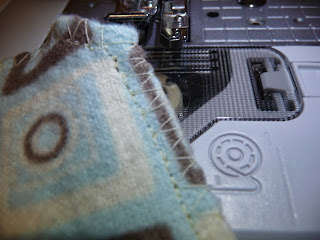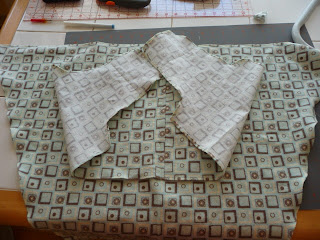I have a darling granddaughter joining us in February! Yes, YoungSon & YSW (young son's wife) are blessing us with our first grandchild. I decided it was time to get sewing and picked what (seemed) to be a very easy swaddler-thing pattern and tutorial from
Prudent Baby. This tutorial even said "new & improved" which led me to believe "easy". Not quite.
Let's see how this worked out for the Kindergarten Crafter:
The initial directions seemed clear enough, until I actually pulled out the scissors. I wasn't the first one with the issue, because in this
new & improved version, she'd drawn a picture of what the cut would look like. That helped quite a bit. I'm geometrically challenged.
First, I cut the giant triangle.
Next, we are supposed to get two floppy pieces out of what's left. Again, her diagram helped, but it wasn't until I went to the
original post (
here) that I could get a better idea of what I was trying to do.
My first cut was a bit short, so I went in and made the skinniest pieces (which will eventually be the flappy ends we tie) a bit narrower.
OK... two of these. And I still think they look kinda wide, but babies don't know nuthin' about geometry, so I'm ahead of them at least.
I do not own a serger. I'd like one, but who in their right mind would buy me a serger when I can barely sew? Obviously, not the Husband. So I make do. You probably do as well. In the tutorial, she thoughtfully suggested bias tape. I hate bias tape. I think it was probably created to make my life a living hell and highlight my kindergarten attempts at sewing. It is much easier to hide wonky stitches on busy material than on nice, single colored bias tape. So no bias tape either.
What I DO own is a sewing machine (shoutout to the Brother SE400. WOOT!) that has something called an OVERCAST stitch. This essentially means "Poor man's serge stitch" and I use it as exactly that. Like a zig-zag that goes over one edge, it does a fair to middlin' job at keeping the edges from fraying. I attempted to use it on the very edge of my flannel fabric, but let me tell you now: DON'T. Flannel is big on fraying. It took me quite awhile to dig the knots out of my machine.
I sorta solved the problem as you see below.
I turned back a smidgen of fabric - maybe an eighth of an inch? - and pressed it down. I then serged overcast stitched around the entire piece of fabric. The first curvy piece was a rude wakeup call that corners and overcast are not soul mates. This was extremely fiddly and slow sewing. For the second curvy piece, I got smart and resorted to my best sewing friend. You can just barely see her below.

Yup, right there smack dab in the middle is a piece of double-stick iron on fusible tape. It was just enough to keep the corners down so I didn't get them all smooshed up sewing over them. And here's a hint: when you come to a corner using an overcast stitch, there's a little bar-like thingie on the foot that keeps your thread at the right tension. You cannot simply STOP, leave needle down, lift presser foot, turn like you can with a normal foot. I found you have to do that, then turn the wheel on your sewing machine for one stitch while the foot is up and then the fabric kind of comes out from under the bar-thingie. (Yes, that sounds confusing, but when you do it once you'll say AHA!) OK... back to serging overcasting.
From the front-side sewing-wise (which is actually the back-side of the project) this isn't so attractive. Although it gets the job done.
From the back (project front side) it's actually sort of cute. It makes the edges somewhat ruffle-y.
I don't know if the ruffle-y thing is an intentional part of the stitch, but I can tell you that my fabric no longer would lay down flat after I used this stitch. Not necessarily a bad thing. Pretend like babies like ruffle-y.
We are now supposed to connect the two curvy pieces, which will eventually be sort of like bat-wings on the back of the blanket and wrap around the front. People with babies probably know this, but I was completely confused on the whole "how does a swaddling blanket work" thing. In the olden days, we just wrapped the kid in whatever we had and they were grateful by gosh! (sorry... practicing my old-folk talk)
The tutorial calls for a french seam. While easy in theory, if you do not read the directions while you are doing it, but instead run back and forth between the computer room and the dining table, you might still mess up and first sew your seams with the RIGHT SIDES FACING. That is WRONG.
Yes, right is wrong for french seams. And quite honestly, I may be seeing a pattern here, but the french can keep their danged seams. I pulled out my mother's 40-ish year old seam ripper and thought I'd show you this family keepsake.
Until I tried it and discovered that a SHARP seam ripper is the way to go. 40+ years of use is not a good thing when it comes to seam rippers.
Go get a sharp one. You'll be glad.
I read somewhere that you should use the short side down and the long side up, but I simply can't make it work that way. Do whatever it takes to get the mistaken threads outta the way. And go slow - mistakes usually mean rips in the fabric. :(
I eventually figured out the seam, but honestly. I thought it was bulky and am not sure why I didn't just join them like I did for the diaper cover.
It might be a strength issue. Someone with more knowledge will have to give you advice on that. For now though, go with the french seam and decide for yourself.
At this point, somebody with baby knowledge would have been able to easily figure out the actual "construction". I was confused. After several tries, placing the fabric on the front and on the back and backwards (there is no upside down on the curvy pieces btw), I decided that below is the desired result.
Since the pattern is so busy, it might be hard to see, but the french-seamed batwing piece is laying on TOP of the long triangle. It's about 3" down from the top and centered left to right. As suggested in the tute, fold the skinny triangle and iron it to find center. I guessed on center on the batwing piece because I just figured the middle of the french seam.
In the new & improved (oh how I love typing THAT phrase) version, the batwing piece is not completely sewn down to the triangle piece. A gap is left so the swaddle-flaps can be stuffed through.*** I didn't measure the distance, just sort of winged it. (no pun intended). I also used something on my machine called a triple-stretch stitch. It's supposed to be strong. I don't actually like it, but you never really know that until you've already sewn it. Live and learn. Use something different on your machine.
Apparently, straight is not my forte.
Although seriously, who would look that closely at a gift?
I trimmed the loose ends but forgot to pull the thread and tie a knot. I actually am not really even sure how to do that or if this triple-stretch stitch even needs it, but with regular straight stitch you want to either reverse over your ends or tie the two ends together. Just in case, I decided to put some fraycheck on these spots.

Fraycheck does NOT want to help you.
It wants to stay closed and make your fingers hurt while you try to stick a "fine needle" down the plastic tube.
Yes, the pin BENT. That's how much fraycheck doesn't want to help. I did eventually get it open and put a couple of dots on the ends of any threads that looked weak. I went around the edges of the entire thing and put a dab or two here and there as well. Just in case. Even the Kindergarten Crafter doesn't want a gift to unravel.
Nevertheless, I completed a Baby Swaddler Blanket. Which looks like a triangle with batwings on it. For those who don't know baby stuff, like me.
 |
| where does the baby go? and why did I leave a gap???? |
It looks SORTA like the original:
 |
| Photo credit: Prudentbaby.com |
And sorta like the new & improved version:
 |
| Photo credit: Prudentbaby.com |
While not perfect, I totally think you could do this. And since the pieces of fabric are fairly big, if you muck it up you can still cut the pieces into something else. Like a diaper cover.
OK, now for the scoring, so you know just what you're getting into.
EASE - On a scale of 1-5 thumbs, 1 being no problem and 5 making me cry, I give this craft:
4 Thumbs
GIFTABILITY - On a scale of 1-5 gifts, 1 being barely giftable and 5 being almost sellable, I give this craft:
4 Gifts
HAPPINESS - On a scale of 1-5 smilies, 1 being UGH and 5 being WOOT!!!, I give this craft:
3 smiles
Skills learned: french seams, fusible tape, overcast stitch, fray check, seam ripper, triple stitch
***What is that gap really for? It makes no sense. I don't have a baby to test it on, but I cannot for the life of me decide what the gap is for. If you know, please let me know. Thanks


























































